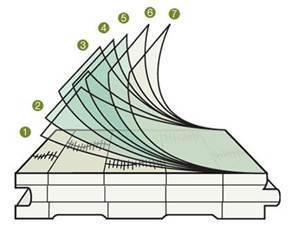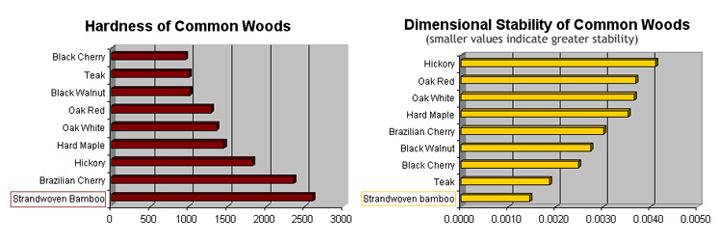Technical Data
Bamboo Flooring Technical Data
| Testing Item | Testing Result |
|---|---|
| Moisture content | 9% |
| Reaction to fire - EN 13501-1 | s1 |
| Content of Pentachlorophenol | < 5ppm |
| Emission of formaldehyde - EN717-1 | 0.015 mg / m3 |
| Breaking strength - EN1533 | 3,655 kg / cm2 |
| Slipperiness - EN1339 | 0.71 |
| Thermal conductivity - EN12524 | 0.146 kcal / m.h.c |
| Biological durability - EN335-1 and EN335-2 | 00144 |
| Layers | Content | Quantity |
|---|---|---|
| 1 | UV Primer | 10 - 15 g / m2 |
| 2 | UV Putty | 15 - 20 g / m2 |
| 3 | Anti-Brasive | 15 - 20 g / m2 |
| 4 | Anti-Brasive | 15 - 20 g / m2 |
| 5 | Duro-Sealer | 15 - 20 g / m2 |
| 6 | Antiscratch | 4 - 6 g / m2 |
| 7 | Antiscratch | 4 - 6 g / m2 |

Bamboo Flooring Coating Layers Display
Janka Hardness Rating: The Janka hardness rating measures the resistance of a wood or bamboo species to wear and denting. Bamboo flooring typically has a Janka hardness rating ranging from 1,300 to 1,600 pounds-force (lbf), depending on the type of bamboo and the manufacturing process. This rating can help determine the durability of the flooring.
Moisture Content: Bamboo flooring should have a moisture content of around 6% to 9% before installation to prevent warping, buckling, or other issues. Proper acclimatization of the flooring to the installation environment is crucial to ensure a stable and long-lasting installation.
Bamboo flooring hardness compared with hardwood



 皖公网安备 34180202000049号
皖公网安备 34180202000049号